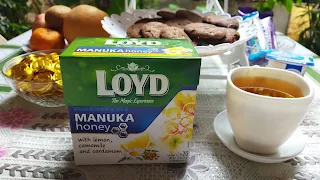Tea is the most popular beverage in the world, next only to water. It is an aromatic beverage prepared by pouring hot over cured or fresh leaves of Camellia sinensis.
Although a lot of tea varieties are already available in the market today, tea experts consider only green tea, black tea, white tea, and oolong tea as real things.
They are all derived from the Camellia sinensis plant, a shrub native to China and India, and contain unique antioxidants called flavonoids. The most potent of these, known as ECGC, may help against free radicals that can contribute to cancer, heart disease, and clogged arteries.
According to Harvard University's Public Health, tea was initially described as a medicinal beverage in China in the 3rd century AD.
The flavor of tea varies by where the tea leaves are harvested and how they are grown and processed. The most popular variety is black tea followed by green, oolong, and white tea.
The teas processed from the Camellia sinensis plant contain caffeine while the herbal teas from dried herbs, spices, flowers, fruit, seeds, roots, or leaves of other plants do not typically contain caffeine.
Both teas, however, are good sources of the following:
- Polyphenols (type of antioxidants from plants)
- Flavonols – myricetin, quercetin, kaempferol
- Theaflavins – formed when black tea leaves are oxidized
- Catechins – found in green tea; epigallocatechin-3 gallate (EGCG) is the main form
Health Benefits
Animal studies suggest potential health benefits of tea due to its high polyphenol content. While human studies have generally been less conclusive, it does show promise (results).
Observational research has found that tea consumption of 2-3 cups daily is associated with a reduced risk of premature death, heart disease, stroke, and type 2 diabetes.
However, it is believed to trigger an increased risk of esophageal and stomach cancers from drinking tea that is too hot (more than 131-140° F [55-60° C]). This finding did not explicitly say - drinking tea is bad, it just emphasized that drinking "too hot water" may increase the risk of stomach and esophageal cancers.
Harvard Public Health stated that randomized controlled trials are needed to confirm if these healthful and harmful associations are causal.
In the meantime, there appears to be little risk associated with drinking tea except for frequent consumption of very hot tea. So avoid sipping your tea when it's too hot, let it cool a bit.
Polyphenols or flavonoids (plant-based antioxidants) are likely key components to what makes tea a healthful drink. Antioxidants of these chemicals control the damaging effects of free radicals in the body.
Free radicals can alter DNA by stealing its electrons, and this mutated DNA can increase LDL cholesterol or alter cell membrane traffic—both harmful to our health.
Green tea is often believed to be richer in polyphenols than black or oolong (red) teas. However, studies show that—with the exception of decaffeinated tea—all plain teas have about the same levels of these chemicals, albeit in different proportions.
Green tea is richest in epigallocatechin-3 gallate (EGCG, a powerful antioxidant that protects the body from inflammation, cardiovascular and other chronic diseases such as cancer) whereas black tea is richest in theaflavins (antioxidant polyphenols).
EGCG and Theaflavins have been shown in research studies with strong health benefits. Herbal teas contain polyphenols as well but will vary highly depending on their plant origin.
However, additional infusions on black and green teas, such as fruits, spices, milk, honey, sugar, and lemon, may alter specific flavonoid contents.
For example, one research study suggests that the protein and possibly the fat in milk may reduce the antioxidant capacity of tea. Flavonoids are known to “deactivate” when binding to proteins so this theory makes scientific sense.
One study that analyzed the effects of adding skimmed, semi-skimmed, and whole milk to tea concluded that skimmed milk significantly reduced the antioxidant capacity of tea.
High-fat milk also reduced the antioxidant capacity of tea, but to a lesser degree. However, Harvard Public Health reminded tea drinkers that tea—even with a splash of milk—can be a healthful drink.
Is decaffeinated tea healthy?
Caffeine is classified as a stimulant that has the potential to affect the nervous system and heart rate. It causes jitteriness (and anxiety). In general, traditional teas already have about half the caffeine of coffee and even less if the brewing time is shorter.
There are different methods to decaffeinate tea. One process uses an organic chemical solvent (either ethyl acetate or methylene chloride) which also potentially removes most of the tea’s polyphenols.
Another method called “effervescence” uses water and carbon dioxide, which retains the majority of polyphenols. Both methods apply the chemical or gas onto moistened tea leaves, which bond to the caffeine; when the leaves are dried, the caffeine evaporates along with the solvent/gas.
You need to check the label of the decaffeinated tea to know which processing method is applied or you may check the website of the manufacturer to get useful information.
Decaffeinated teas are those black, green, white, and oolong (red) teas. Herbal teas are naturally caffeine-free and do not undergo a decaffeination process.
Studies on decaffeinated teas are very limited because most research studies conducted are focusing on the health benefits of traditional teas, not decaffeinated.
Decaffeinated tea may lose polyphenols that are associated with health benefits, depending on the processing method used.
Traditional teas originated from the Camellia sinensis plant, these include black, white, green, yellow, oolong, and yerba mate teas, all of which contain caffeine.
Black tea is made by crushing and drying fresh tea leaves and allowing them to ferment, which oxidizes the leaves and changes their color and flavor. Oolong tea is partly fermented but green tea undergoes no fermentation process. Matcha is a special form of green tea in which the dried leaves are ground into a fine powder.
Herbal teas that are naturally caffeine-free include chamomile, peppermint, vanilla, turmeric, ginger, and fruit essence teas. They may have notes of floral, fruit, mint, spice, grassiness, sweetness, or bitterness.
Source: Harvard School of Public Health
Antioxidant
According to the definition provided by the National Cancer Institute, an antioxidant is a substance that protects cells from the damage caused by free radicals (unstable molecules made by the process of oxidation during normal metabolism). Free radicals may play a part in cancer, heart disease, stroke, and other diseases of aging.
It inhibits oxidation, especially one used to counteract the deterioration of stored food products. Antioxidant removes potentially damaging oxidizing agents in a living organism.
Examples of antioxidants: Vitamins A, C, and E, selenium, and carotenoids, such as beta-carotene, lycopene, lutein, and zeaxanthin.
Caffeine
Caffeine is a stimulant that boosts energy but it brings discomfort to those who suffer from acid reflux, it can also irritate the nerves and triggers stomach upset and anxiety. Moreover, it can also be addictive if the intake is not moderated.
The FDA (Food and Drug Administration) in the United States warned consumers to limit their caffeine intake to just 200 milligrams a day or three cups of coffee a day because of its unhealthy effect on the body.
An average cup of coffee is estimated to contain around 90mg of caffeine. While carbonated soda, particularly coke has 34mg of caffeine per 12ounce-can. This is why most people now preferred tea over coffee because tea has lesser caffeine content.
Black tea contains 30 mg per tea bag, followed by green tea with 20mg. White Ceylon tea has the lowest caffeine level at just 10mg.
While teas from the Camellia Sinensis plant contain caffeine, herbal teas, such as Loyd Tea in Manuka flavor, which is an infusion of herbs, fruits, and honey, are relatively caffeine-free.
Herbal teas, also called tisanes, are not made from the Camellia plant but from dried herbs, spices, flowers, fruit, seeds, roots, or leaves of other plants, and they do not typically contain caffeine.
Teas are full of flavonoids and phytochemicals
Flavonoids, a group of natural substances with variable phenolic structures, are found in fruits, vegetables, grains, bark, roots, stems, flowers, tea, and wine. These natural products are well known for their beneficial effects on health.
Tea is particularly rich in 3 flavonoid classes: flavan-3-ols (or catechins), oligomeric flavonoids (including thearubigins and theaflavins generated during fermentation), and flavonols.
Phytochemicals are compounds in plants. (Phyto means “plant” in Greek.) These substances are found in plant-based foods such as fruits, vegetables, whole grains, nuts, seeds, and legumes. They give plants their color, flavor, and aroma
Phytochemicals may decrease the risk of developing certain cancers as well as diabetes, hypertension, and heart disease. The action of phytochemicals varies by color and type of food. They may act as antioxidants or nutrient protectors or prevent carcinogens (cancer-causing agents) from forming.
Sources of phytochemicals.
Take note that phytochemicals cannot be found in supplements and are only present in food.
- Allicin - found in onions and garlic. Allicin blocks or eliminates certain toxins from bacteria and viruses.
- Anthocyanins - found in red and blue fruits (such as raspberries and blueberries) and vegetables. They help to slow the aging process, protect the body against heart disease and tumors, prevent blood clots, and fight inflammation and allergies.
- Bioflavonoids - found in citrus fruits.
- Carotenoids are found in dark yellow, orange, and deep green fruits and vegetables such as tomatoes, parsley, oranges, pink grapefruit, and spinach.
- Flavonoids - found in fruits, vegetables, wine, tea, onions, apples, kale, and beans.
- Indoles - found in broccoli, cabbage, kale, Brussels sprouts, and turnips (also known as "cruciferous" vegetables). They contain sulfur and activate agents that destroy cancer-causing chemicals.
- Isoflavones - found in soybeans and soybean products.
- Lignins - found in flaxseed and whole grain products.
- Lutein - found in leafy green vegetables. It may prevent macular degeneration and cataracts as well as reduce the risk of heart disease and breast cancer.
- Lycopene - found primarily in tomato products. When cooked, it appears to reduce the risk of cancer and heart attacks.
- Phenolics - found in citrus fruits, fruit juices, cereals, legumes, and oilseeds. It is thought to be extremely powerful and is studied for a variety of health benefits including slowing the aging process, protecting against heart disease and tumors, and fighting inflammation, allergies, and blood clots.
Teas are keys to good health, happiness, and wisdom. Studies have found that some teas may help with cancer, heart disease, and diabetes; encourage weight loss; lower cholesterol; and bring about mental alertness. Tea also appears to have antimicrobial and anti-inflammatory qualities.
Source: Stanford Health Care
“There doesn’t seem to be a downside to tea,” says American Dietetic Association spokeswoman Katherine Tallmadge, MA, RD, LD. “I think it’s a great alternative to coffee drinking. First, tea has less caffeine. It’s pretty well established that the compounds in tea – their flavonoids – are good for the heart and may reduce cancer.”
Different kinds of tea explained:
Green tea. Made with steamed tea leaves, it has a high concentration of EGCG and has been widely studied. Green tea’s antioxidants may interfere with the growth of bladder, breast, lung, stomach, pancreatic, and colorectal cancers; prevent clogging of the arteries, burn fat, counteract oxidative stress on the brain, reduce risk of neurological disorders like Alzheimer’s and Parkinson’s diseases, reduce risk of stroke, and improve cholesterol levels
Black tea. Made with fermented tea leaves, black tea has the highest caffeine content and forms the basis for flavored teas like chai, along with some instant teas. Studies have shown that black tea may protect the lungs from damage caused by exposure to cigarette smoke. It also may reduce the risk of stroke. Earl Grey Tea is an infusion of black tea and oil of bergamot.
White tea. Uncured and unfermented. One study showed that white tea has the most potent anticancer properties compared to other processed teas.
Oolong tea. In an animal study, those given antioxidants from oolong tea were found to have lower bad cholesterol levels. One variety of oolong, Wuyi, is heavily marketed as a weight loss supplement, but science hasn’t backed the claims.
Pu-erh tea. Made from fermented and aged leaves. Considered a black tea, its leaves are pressed into cakes. One animal study showed that animals given pu-erh had less weight gain and reduced LDL cholesterol.
Herbal Teas. Made from herbs, fruits, seeds, or roots steeped in hot water, herbal teas have lower concentrations of antioxidants than green, white, black, and oolong teas. Their chemical compositions vary widely depending on the plant used.
Herbal tea varieties include ginger, ginkgo Biloba, ginseng, moringa, ashitaba, hibiscus, jasmine, rosehip, mint, rooibos (red tea), chamomile, and echinacea.
Limited research has been done on the health benefits of herbal teas, but claims that they help to shed pounds, stave off colds, and bring on restful sleep are largely unsupported.
Here are some findings:
Chamomile tea: Its antioxidants may help prevent complications from diabetes, like loss of vision and nerve and kidney damage, and stunt the growth of cancer cells.
Echinacea: Often touted as a way to fight the common cold, the research on echinacea has been inconclusive.
Hibiscus: A small study found that drinking three cups of hibiscus tea daily lowered blood pressure in people with modestly elevated levels.
Rooibos (red tea): A South African herb that is fermented. Although it has flavonoids with cancer-fighting properties, medical studies have been limited.
Can Tea Be Bad for Your Health?
Most teas are benign, but the FDA has issued warnings about so-called dieter’s teas that contain senna, aloe, buckthorn, and other plant-derived laxatives.
The agency also warns consumers to be wary of herb-containing supplements that claim to kill pain and fight cancer. None of the claims is backed by science and some of the herbs have led to bowel problems, liver and kidney damage, and even death.
Source: Tea Types and Health Benefits from Web MD
There's a perfect tea option for your health needs. Here's how to pick a tea of your choice that addresses a specific health concern, according to Cleveland Clinic in the United States:
- Best for Overall Health: Green Tea
- Best for Gut Health: Ginger Tea
- Best for Lung Health: Herbal Tea
- Best for Sickness: Peppermint Tea
- Best at Bedtime: Chamomile Tea
Black tea offers many of the same benefits as green tea because they are sourced from the same plant leaves. However, they differ in the processing method.
Leaves used to make black tea are allowed to age and oxidize, turning them brown or black. Green tea leaves are processed earlier when they’re still green. Hence, the name.
Black tea generally has more caffeine than green tea, so it makes sense to pick green tea if you need to limit your caffeine intake. In addition, green tea is healthier than black tea due to the higher amount of antioxidants.














0 Comments